Mercedes-Benz E-Class: Model History and Buyer’s Guide
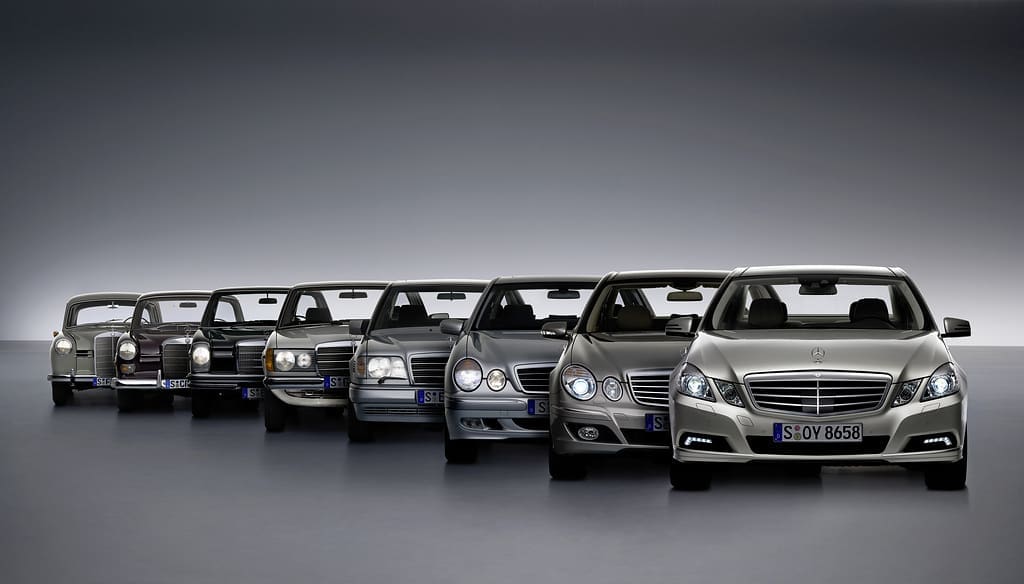
Contents
- Introduction
- Generations
- W124 (1986-1995)
- W210 (1996-2002)
- W211 (2003-2009)
- W212 (2010-2016)
- W213 (2017-2023)
- Performance Variants
- 500E / E500 (W124)
- E55 AMG (W210)
- E55 AMG / E63 AMG (W211)
- E63 AMG (W212)
- E63 S (W213)
- Buying Advice
- Under $10,000
- $10,000 to $20,000
- $20,000 to $30,000
- Over $30,000
- Pre-Purchase Inspections (PPIs)
Introduction
The E-Class may not be the most iconic car to come from Mercedes-Benz. That honor likely belongs to something a bit more extravagant, such as the 300SL Gullwing.
But that doesn’t make the E-Class any less significant to the brand. It has long been the most practical car in the German automaker’s lineup. Indeed, since Benz first introduced a midsize sedan back in the 1950s, the E-Class has represented a near-perfect combination of size, comfort, and value.
Equally capable of running errands, handling the daily commute, or hauling the family across the country, the E-Class is the ultimate do-anything vehicle. And while it’s never been cheap, it’s built well enough to provide decades of useful service.
If you’re in the market for an E-Class Mercedes, you have quite a few options, ranging from classic models to modern cars laden with cutting-edge tech. In this buyer’s guide, we’ll give you the scoop on every E-Class generation from the last thirty years to help you find the perfect one.
Generations
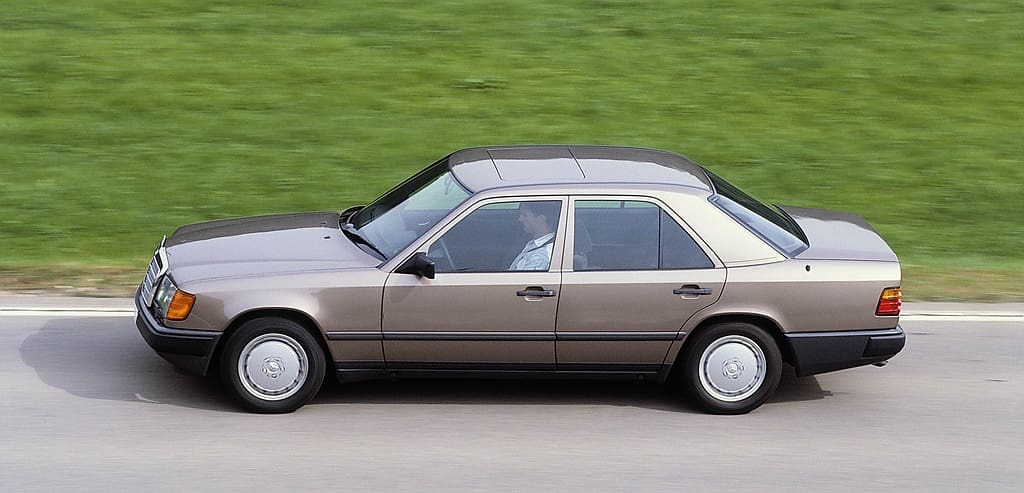
W124 (1986-1995)
- The first Mercedes-Benz to wear the E-Class badge
- Offered in a wide range of body styles, including sedan, wagon, coupe, and convertible
- Known for its robust build quality, making it an enduring choice on the used car market
Mercedes has been building midsize cars for 70+ years, but it wasn’t until the early 1990s that the E-Class moniker officially appeared. That’s when the marketing execs changed the naming convention for all MB models, flipping them from numbers followed by letters — such as “300E” — to letters followed by numbers — such as “E300.” Thus, the E-Class was born.
The first model to be called an E-Class actually dates back to 1986, when the W124 generation debuted (in the US). Replacing the beloved but aging W123 series, the W124 nudged the midsize Mercedes into the modern era. Its sleek and relatively unadorned skin, penned by legendary designer Bruno Sacco, was a dramatic departure from the traditional look of the outgoing car.
Under the hood, that modernization continued. In the US, most versions of the W124 were fitted with a new 3.0-liter inline six, making 177 horsepower and 188 lb-ft of torque — a significant increase over the W123, which featured primarily diesel power. Starting in 1993 (for sedans and wagons), the big six got bumped to 217 horsepower thanks to the addition of a dual overhead cam and variable valve timing. A scant few W124s made it onto American soil with a five-speed manual gearbox. The majority, though, featured Benz’s ubiquitous (at the time) four-speed automatic.
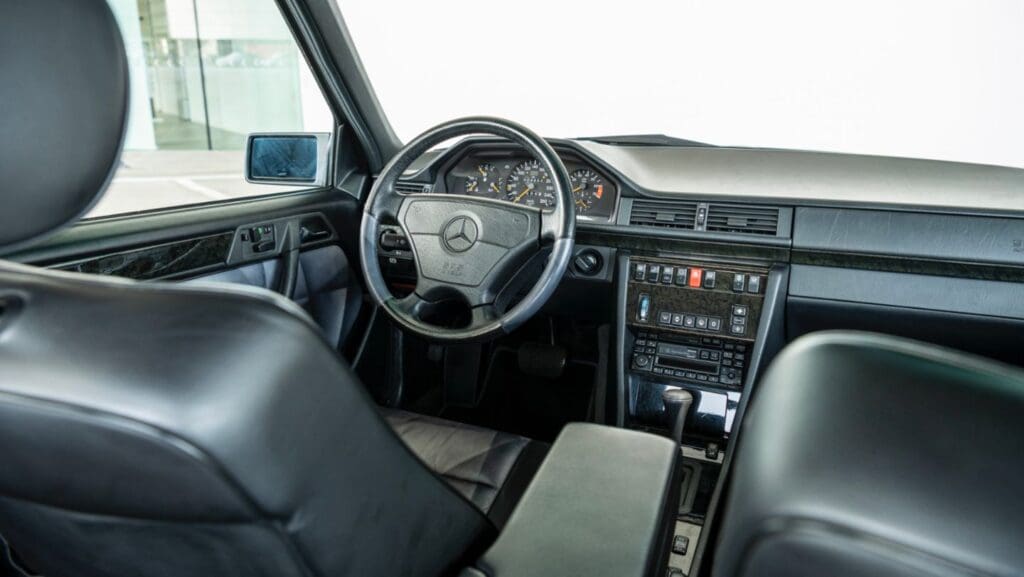
Mercedes kept things simple inside the no-nonsense W124 cabin, where luxury was defined more by the quality of the materials than by the number of fancy features.
Offered in sedan, wagon, coupe, and even convertible variants, the W124 offered something for almost every buyer — as long as they had some serious cash on hand. Prices for the W124, when new, started in the mid-$30,000s and ran as high as $80,000 for the rare V8-equipped performance model, the 500E. And that’s not adjusted for inflation.
Even so, the W124 sold well through its 10-year run. Thanks to its popularity and its famously robust build quality, you can still find good examples on the road today.

W210 (1996-2002)
- Roomier cabin, especially for rear passengers, but materials quality suffers from cost-cutting
- More responsive five-speed automatic added in 1997, with new V6 and V8 engines following one year later
- New safety features include side airbags and emergency braking assist (starting in 1998)
The venerable W124 series, which proved to be one of the best-selling models in Mercedes-Benz history, was a tough act to follow. But its successor, the W210-generation E-Class, made a valiant effort — especially considering the circumstances under which it was developed.
During the 1990s, Mercedes went through significant changes. The automaker was facing steep competition from upstarts such as Lexus that were delivering Benz-like levels of quality for thousands less. That pressured Mercedes to end their longstanding approach to car building. No longer would they engineer the best car possible, no matter the cost. Instead, they would build cars to strict cost targets.
That puts the W210 in the unfortunate position as the first E-Class from Mercedes’ new budget-conscious era. The quality of its materials, especially inside the cabin, isn’t quite up to the high bar set by the W124. But the W210 improved upon the W124 in other ways.
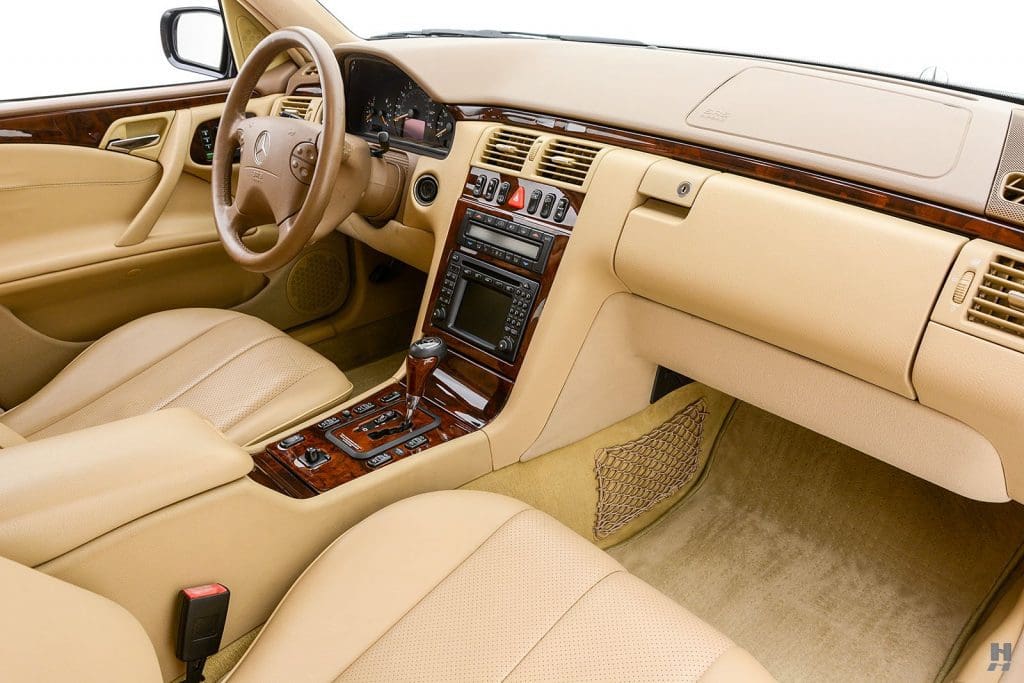
For one, thanks to a slightly longer wheelbase and better overall packaging, the W210 is noticeably roomier inside. Rear seat passengers benefit the most, gaining almost three additional inches of legroom. Otherwise, the cabin retains the W124’s traditional MB look and feel, with simple and easy-to-read gauges, supportive seats, and a large greenhouse offering excellent outward visibility.
The W210 also enjoys a host of mechanical upgrades over its predecessor. In 1997, Mercedes added a fifth cog and electronic control to the automatic transmission, making it more responsive than the W124’s old-school hydraulic unit. Then, in 1998, the W210 gained a series of new engines, offering power and fuel efficiency boosts, plus an optional all-wheel drive system dubbed 4matic.
Safety, too, improved with the W210. New features include standard side airbags (in addition to driver and passenger airbags), traction control, and (starting in 1998) emergency braking assist.
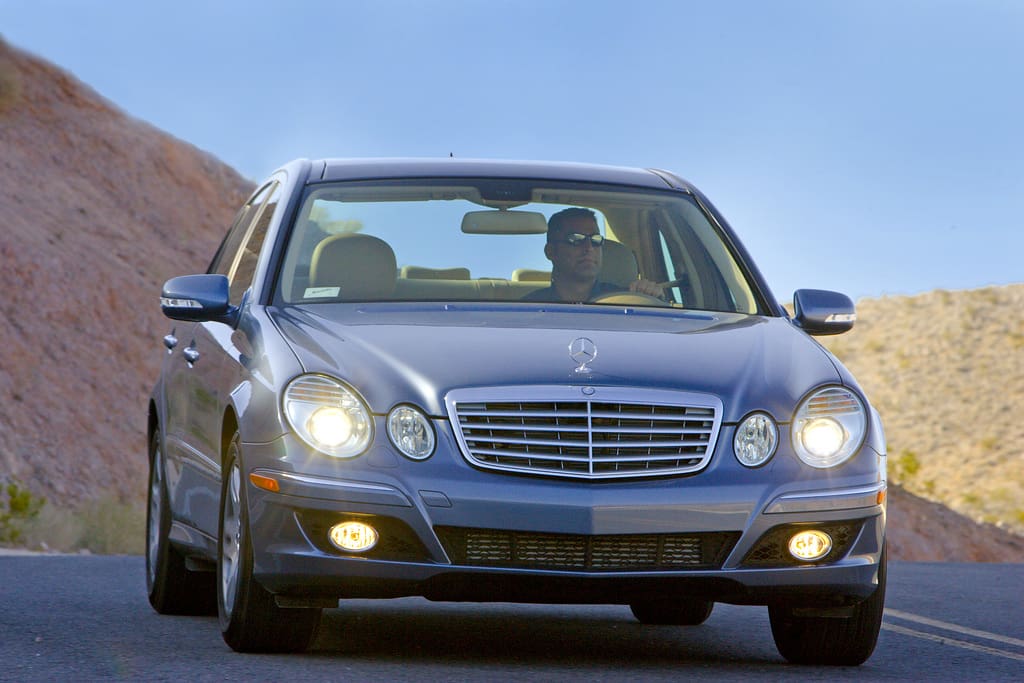
W211 (2003-2009)
- High-strength materials improve strength and minimize weight gain
- New amenities include available heated and ventilated seats, adaptive cruise control, and a panoramic sunroof
- A 2006 refresh introduces a new seven-speed automatic gearbox and updated V6 and V8 engines
Mercedes launched the third-gen E-Class in 2002 as a 2003 model (in the US). Known internally as the W211 series, it continued in the same vein as the outgoing version, offering more room, power, and features while subtly updating — and, to our eyes, improving — its classic round-headlamp styling.
Despite its sleeker and more aerodynamic shape, the W211 E-Class keeps the W210’s generous interior dimensions. Its structure is also notably stouter, thanks to the extensive use of high-strength steel and aluminum. In fact, the latter makes up 60% of the body (compared to just 6% for the W210). That helps keep weight gain to almost nil despite the addition of many new features.
Those new features are most evident once you settle behind the wheel. Where earlier E-Class cabins can feel a bit austere, the W211, by contrast, lavishes its occupants with modern amenities. They include available heated and ventilated seats, four-zone automatic climate control, voice-controlled navigation, adaptive cruise control, and a panoramic sunroof.
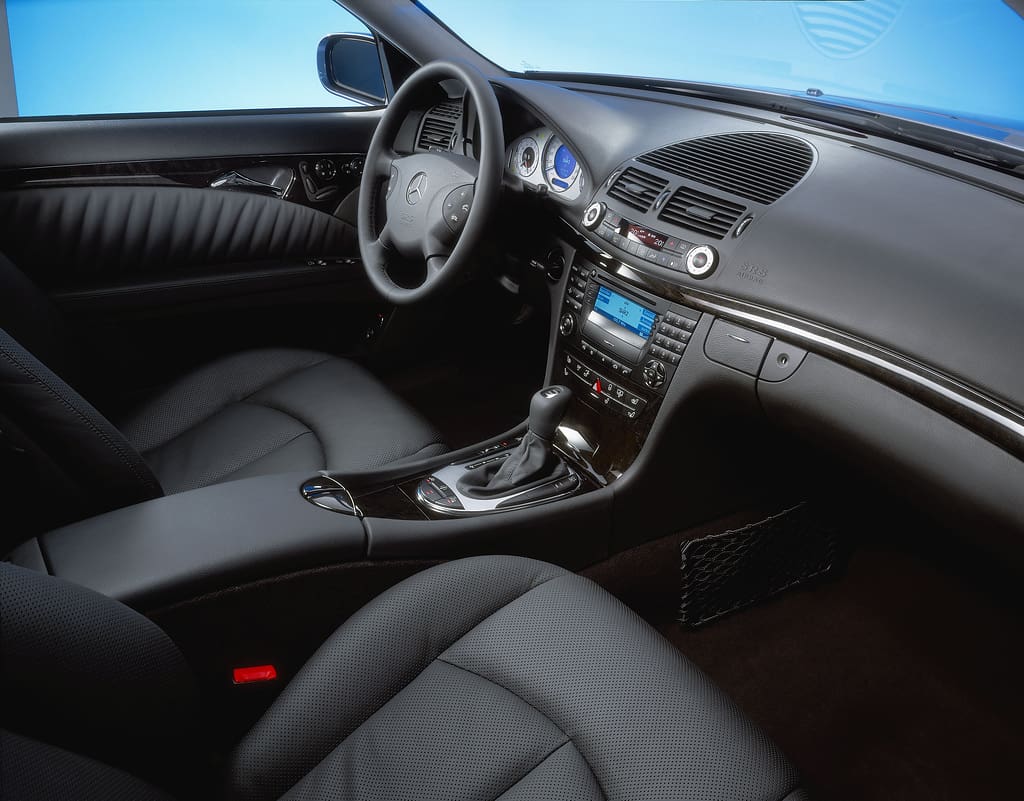
The W211 also had a few new tricks up its wheel wells. The most significant was an available adaptive air suspension borrowed from the S-Class. Known as Airmatic, the system offers three stiffness settings (Comfort, Sport I, and Sport II) and actively manages the car’s motions over bumps and around bends. Additionally, a new seven-speed automatic gearbox found its way into the third-gen E-Class starting in 2006.
As with the W210, most W211 buyers opted for the sedan, though a long-roof version remained available for those Mercedes wagon die-hards. Most also went for the V6 engine, which initially produced 221 horsepower but, for the 2006 model, got a bump in displacement, upping power to 268 ponies. A muscular V8 was available, too, as was a surprisingly thrifty turbodiesel.
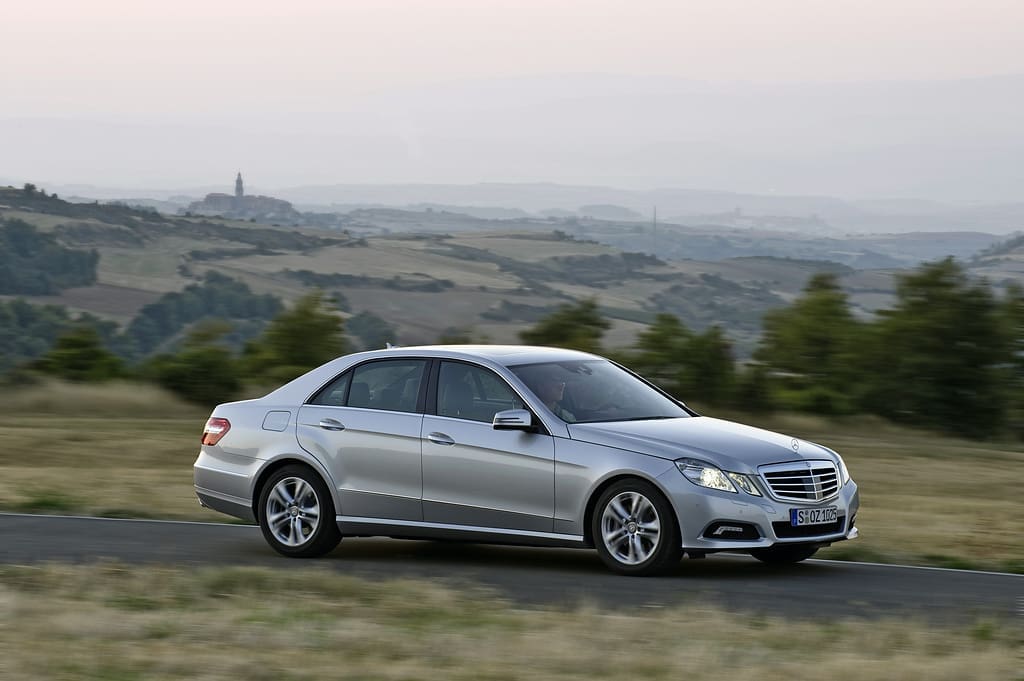
W212 (2010-2016)
- More aggressive, aerodynamic design coupled with a 30% stiffer structure
- More efficient V6 and V8 engines debut in 2012, with a fuel-sipping turbodiesel variant coming in 2014
- Available safety tech includes blind-spot warning, lane-keeping assist, and infrared night vision
With the fourth generation, the E-Class completed its evolution into a thoroughly modern car. The W212 series, as it’s known, first rolled into showrooms for the 2010 model year (in the US) and was met with nearly unanimous praise. In their review at the time, Edmunds called it “a luxury-car triumph.”
The most obvious change was in the looks department. The W212’s angular lines and trapezoidal face depart sharply from the elegant curves of the prior generation. The result is a more aggressive-looking E-Class that’s lower, wider, and longer than its predecessor.
The new shape helps the W212 cut through the air better than most other cars on the road, even today, earning a remarkably low drag coefficient of 0.25. That means, despite using the same powertrain as the outgoing model, the fourth-gen E-Class still improves upon it in both acceleration and fuel economy. The W212’s structure is also 30% stiffer, thanks to additional high-strength steel, ensuring that bank vault solidity remains an E-Class trademark.
Inside the cabin, a large screen takes center stage, featuring Benz’s relatively easy-to-use Command interface for navigation and audio. Quality abounds, with large expanses of wood, soft-touch plastics, and weighty switchgear. The seats retain excellent levels of long-haul support, while the gearshift lever moves to the steering column, freeing up space in the center console for more storage.
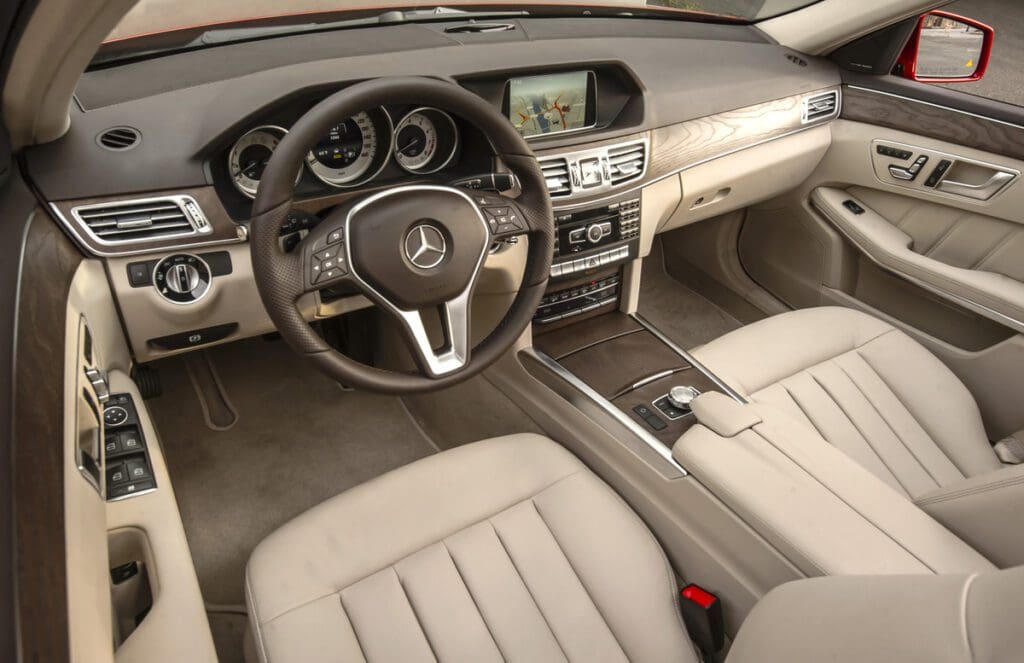
Mercedes again focused on sharpening the E-Class’ competitive edge through new features, especially on the safety front. Attention Assist, a first of its kind, monitors the driver’s alertness and issues warnings if drowsiness is detected. Other available tech, such as a blind-spot warning system, adaptive cruise control, lane-keeping assist, and even infrared night vision, makes it hard to believe the W212 debuted over ten years ago.
The W212’s mechanicals got some notable upgrades through its seven-year lifespan. In 2012, new V6 and V8 engines upped both power and efficiency, while a new hybrid model, the E400, debuted in 2013, delivering an EPA-rated 26 miles per gallon in combined driving. But top fuel-economy marks go to the turbodiesel variants — particularly the four-cylinder E250 Bluetec, which first appeared in 2014 and achieved a remarkable 33 mpg rating (combined).
The 2014 model year also brought a significant refresh to the W212, featuring a more streamlined exterior design and a more upscale interior (pictured above).
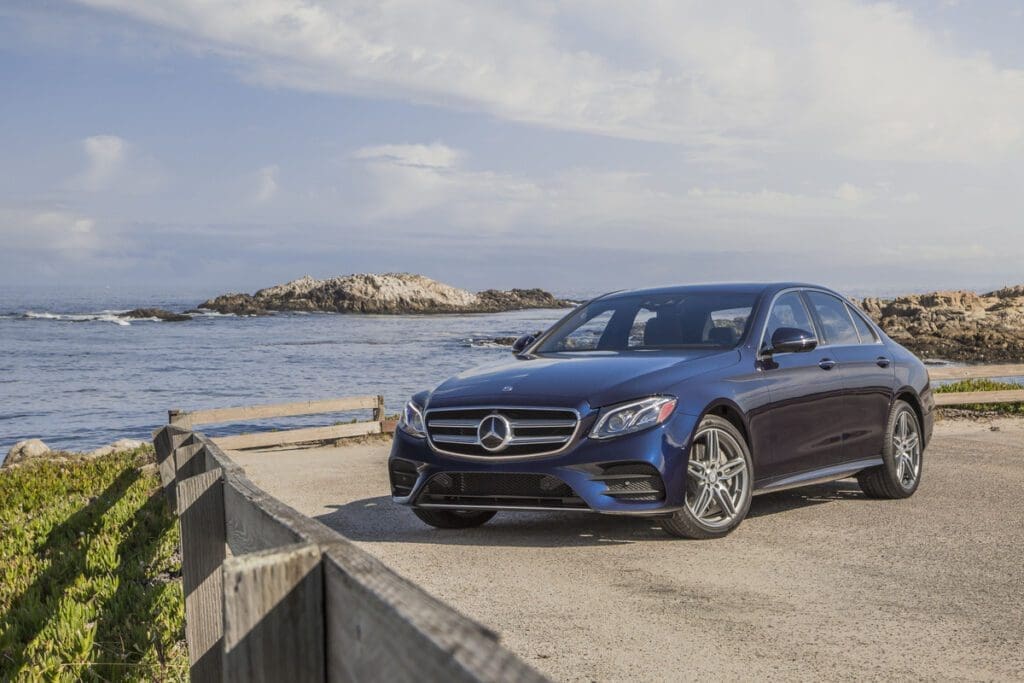
W213 (2017-2023)
- New four-cylinder base engine paired with a nine-speed automatic for improved fuel economy
- Return of four body styles (sedan, wagon, coupe, convertible) for the first time since the W124
- Balance of old-world luxury with cutting-edge tech, including Apple CarPlay and Android Auto integration and semi-autonomous driving
The current iteration of the E-Class, known as the W213 generation, debuted for the 2017 model year (in the US). Building on the prior version’s 2014 refresh, the W213 looks sleeker still, with swept-back curves from bow to stern. And it doesn’t just look sleek. Its ultra-low 0.23 drag coefficient makes it one of the most aerodynamic cars ever produced.
The theme of efficiency carries through to the W213’s powertrain. It’s the first E-Class to offer predominantly four-cylinder power (in the US), fitting Benz’s 2.0-liter turbocharged four-banger in the base model. While down on horsepower compared to the prior base E-Class, which featured a V6, the W213 makes the most of its humbler mill by pairing it with a new nine-speed automatic transmission. Those two additional gears, combined with a slight weight reduction from the W212 chassis, help to keep acceleration competitive (0-60 mph in 6.3 seconds) while improving fuel economy by 2 miles per gallon (to 25 mpg combined).
The W213 is the first E-Class generation since the W124 to offer four different body styles: sedan, wagon, coupe, and convertible. Yes, between the W124 and the W213, Mercedes sold coupes and convertibles badged as E-Classes; however, they were actually based on the smaller C-Class chassis. With the W213, they’re the real deal.
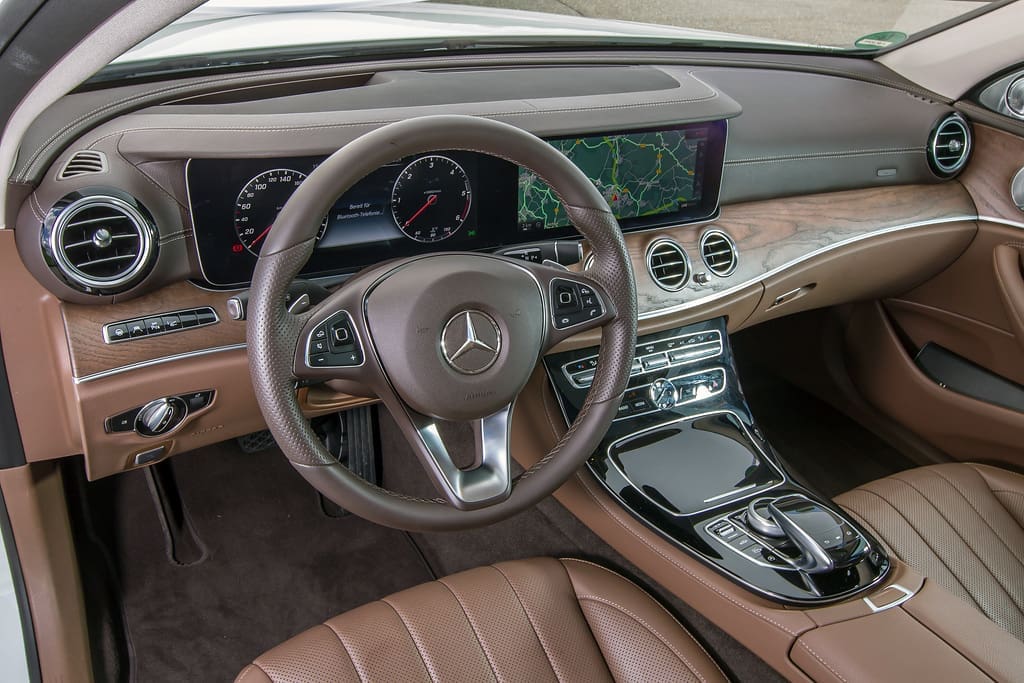
The E-Class cabin leaps a fully digital experience with the W213. A pair of 12.3-inch screens mounted side-by-side offer the driver a set of configurable digital gauges plus a massive infotainment touchscreen, both in high definition. All that sophisticated tech is complemented by warm touches of old-world luxury, such as sweeping wood accents, round metal air vents, a top-stitched dash, and an analog clock.
The W213 is also a showcase of active safety tech, much borrowed from its big brother, the flagship S-Class. Among the available options are semi-autonomous driving with lane-change assist, adaptive LED headlights, head-up display, and evasive steering assist, which helps the driver retain control of the car during emergency maneuvers.
Mercedes has made some notable changes to the W213 since its 2017 debut. Those seeking additional oomph can find it in a smooth and powerful turbocharged six-cylinder model, the E400 (later renamed the E450), which first appeared in 2018. The base four-cylinder model also got a slight bump in power (to 255 hp) for the 2020 model year, earning it a new E350 badge. And for 2021, Mercedes refreshed the entire W213 line with revised exterior styling plus a new infotainment system, dubbed MBUX.
Performance Variants
While the E-Class is known primarily for its ability to transport people in serene comfort and safety, a handful of high-performance variants have appeared through the years.
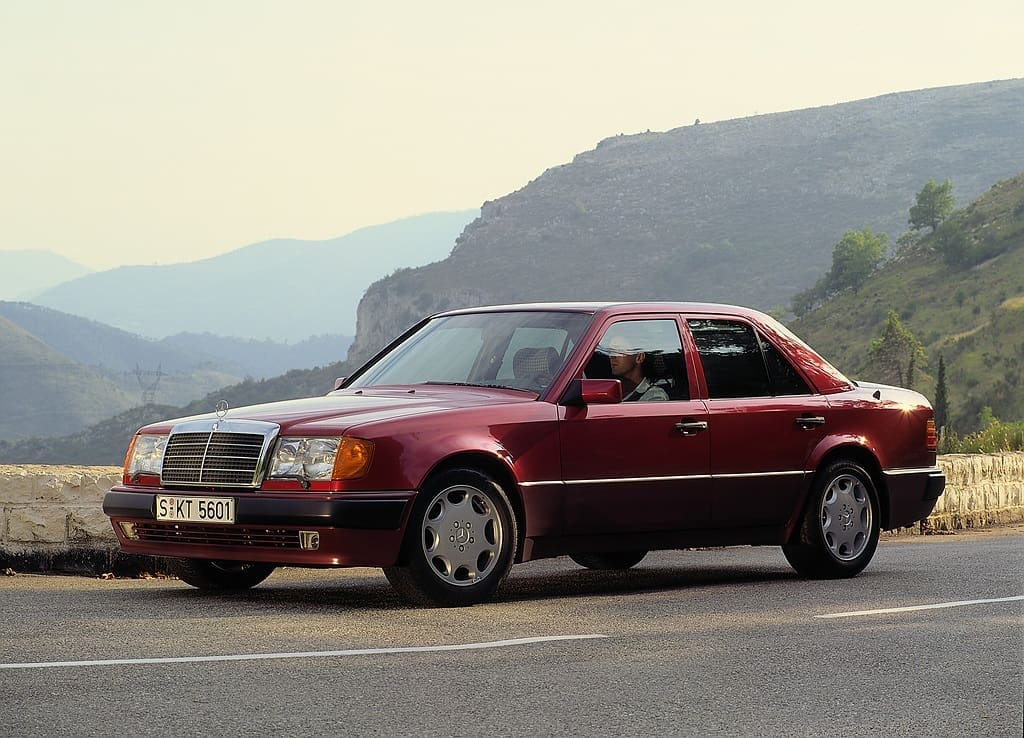
500E / E500 (W124)
- Built in collaboration with Porsche
- 320-horsepower 5.0-liter V8 plus upgraded brakes, steering, and suspension
- Fender flares for larger wheels and Recaro seats in both rows
In the early 1990s, Mercedes engineers teamed up with their Stuttgart neighbors at Porsche to develop an autobahn-storming version of the otherwise staid W124 sedan: the 500E. They started by stuffing the sophisticated 5.0-liter V8 from the R129-generation SL under the hood. Making 322 horsepower and a whopping 354 lb-ft of torque, the engine launched the sedan to 60 miles per hour in six seconds flat on its way to a 155 mph (limited) top speed.
To haul it back down from those lofty digits, the 500E also borrowed the SL’s larger brakes. That, plus a quick-ratio steering box, some suspension tweaks, and larger wheels and tires, completed the mechanical upgrades. The bigger wheels had to be accommodated by pronounced fender flares — one of the only noticeable differences from a stock W124. Another is the cabin with its heavily bolstered Recaro bucket seats in front and back.
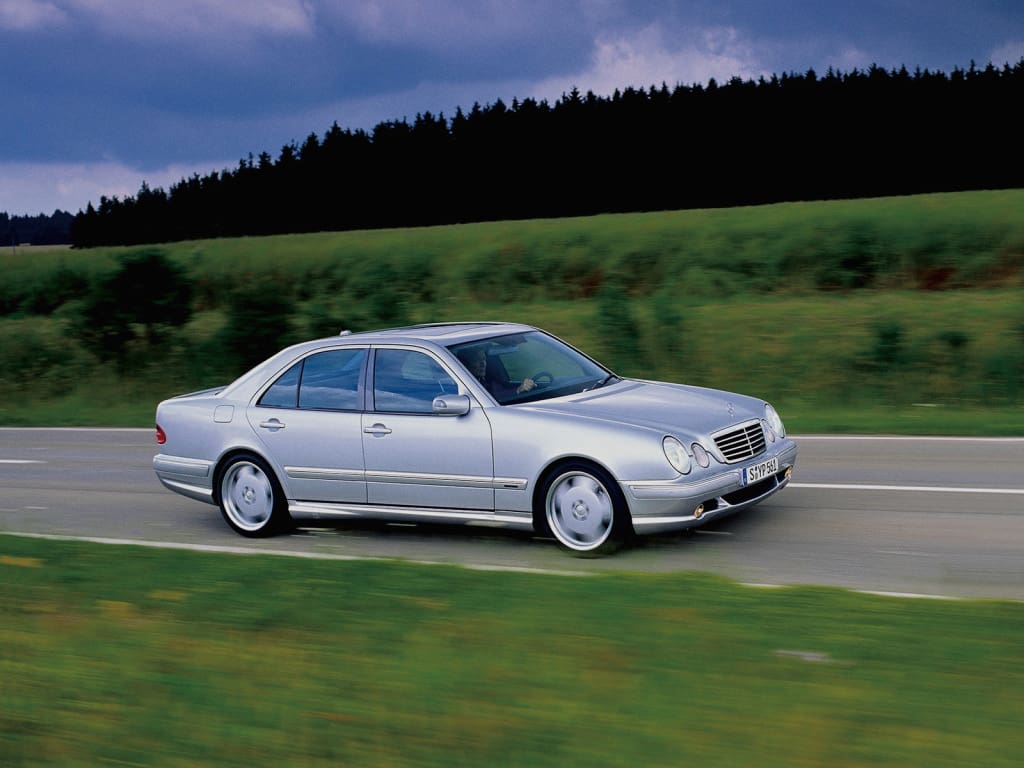
E55 AMG (W210)
- First E-Class from AMG in the U.S.
- Upgraded 5.4-liter V8 with 329 horsepower
- Enhanced suspension, brakes, and 18-inch staggered wheels
The first E-Class to be imported to the US from famed Mercedes tuner AMG was the 1999 E55. Based on the W210 sedan, the E55 AMG took the 500E formula to the next level. Not only did it borrow an engine from the SL, it stroked it to 5.4 liters, updated the head, and fitted a forged crankshaft. These and other tweaks wrung 329 horsepower and 391 lb-ft of twist from the motor. Paired with the W210’s five-speed automatic, it could send the E55 to 60 mph in a tick under five seconds — a full second faster than the 500E.
AMG also upgraded the E55’s suspension, brakes, and wheels (swapping in staggered 18-inch Monoblock alloys) to ensure the chassis could capitalize on the heady performance of the engine.
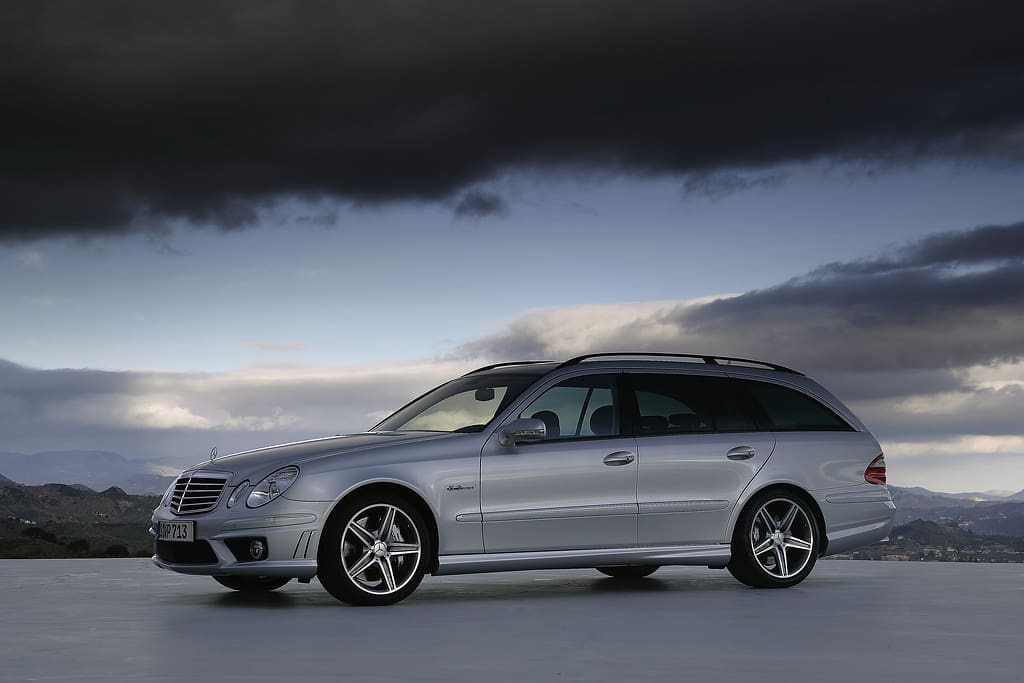
E55 AMG / E63 AMG (W211)
- The E55’s supercharged 5.4-liter V8 offers 469 horsepower, making it the fastest Mercedes at the time
- The famed E63 debuts in 2007 with a 6.2-liter naturally aspirated V8 making over 500 horsepower
- An AMG wagon variant joins the sedan for the first time in the U.S.
AMG upped the ante considerably with the W211-generation E55, which first appeared for the 2003 model year (in the US). By adding a supercharger to the already potent 5.4-liter V8, they squeezed another 120 hp and 125 lb-ft of torque from the engine. That’s 469 hp and 516 lb-ft in total. The added power made the second-gen E55 the fastest Mercedes to date, capable of 4.5-second sprints to 60 mph. Keep your foot in it, and the speedo sweeps into double digits in less than ten counts of Mississippi.
With great power comes… great brakes? Indeed. AMG delivers here, too, with massive rotors sporting 8-piston calipers up front. And to keep the E55’s body in check, they fitted a modified version of the W211’s Airmatic suspension setup. It offers three levels of adjustability, so you don’t have to drive to the grocery store on track-stiff dampers.
If that’s not enough, AMG turned the volume to 11 for the final three years of the W211, swapping the E55’s supercharged V8 for a naturally aspirated 6.2-liter monster. Badged as the E63 (a name that harkens back to an earlier tuner Benz, the 300SEL 6.3), the new version pumps out a tire-roasting 507 horsepower. Fitted with the W211’s new seven-speed automatic, it drops 0-60 times to four seconds flat.
Best of all, with the W211-generation AMG, Mercedes saw fit to bring not just the sedan to our shores but also the longroof version (pictured above).
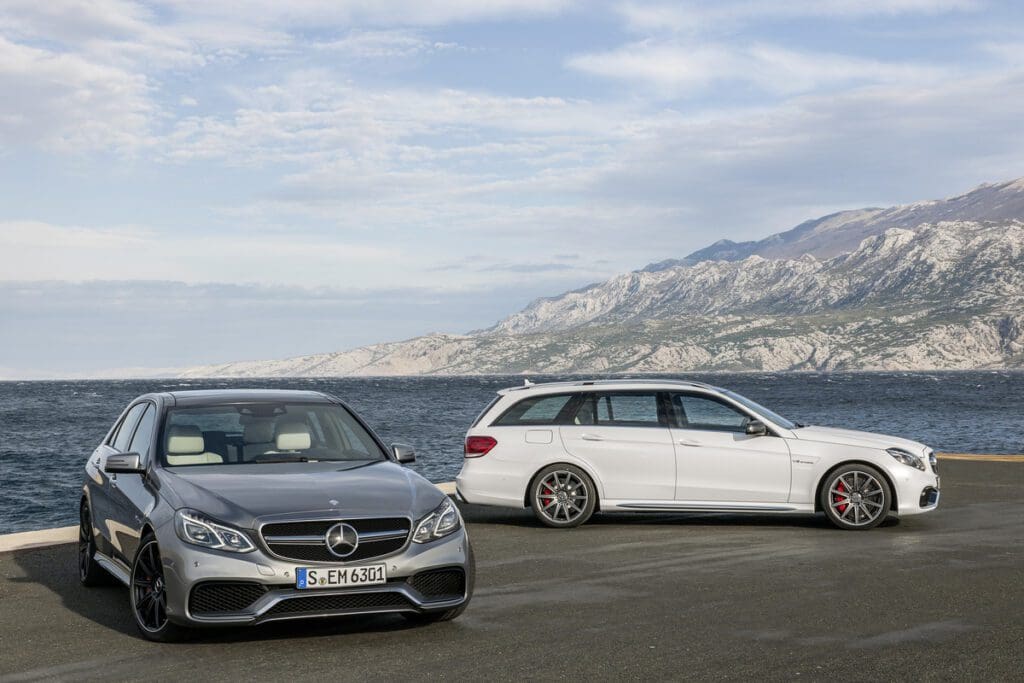
E63 AMG (W212)
- Suspension upgrades and a wider front track improve handling
- Shifts from a 6.2-liter V8 to a 5.5-liter twin-turbo unit in 2012, maintaining horsepower while increasing torque
- A 2014 refresh adds all-wheel drive and increases standard horsepower to 550
AMG carried the spectacular 6.2-liter V8 over to the new W212 chassis to create the 2010 E63 AMG. This time, though, they went even further — not just tweaking the standard suspension but replacing major components. They swapped in a wider front axle, increasing its track by 2.2 inches. They also ditched the front air springs in favor of heavy-duty coils. An available Performance package adds even more stiffness, plus a limited-slip differential and larger 19-inch forged alloys.
The gearbox also gets an upgrade. AMG ditched the seven-speed’s torque converter in favor of a wet clutch connection for quicker cog swaps. The revised ‘box sports five different drive modes, capable of dialing up seamless gear changes around town or rev-matched downshifts on the backroads. It also offers launch control.
AMG phased out the big 6.2-liter V8 for the 2012 model year. In its place, they fitted a 5.5-liter unit with twin turbos. The new motor produces the same horsepower figure, but torque jumps to 516 ft-lbs at just 1750 rpm. Should you find that wanting, a Performance package boosts output to 550 hp and 590 lb-ft.
With the 2014 model refresh, the W212 E63 gained not just a restyled exterior but also Benz’s 4matic all-wheel drive system. The latter helps to get all of that twin-turbo V8 power — now 550 hp standard and 577 hp for the S model — to the pavement, dropping 0-60 times under four seconds.
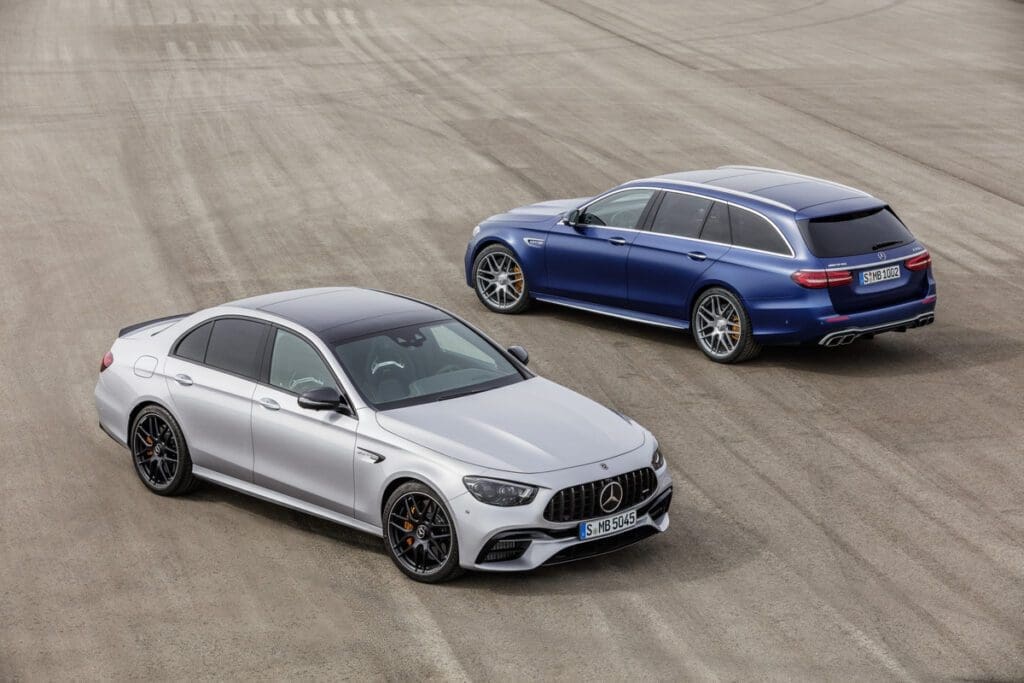
E63 S (W213)
- The twin-turbo V8 now generates over 600 horsepower
- Drift mode added for rear-wheel tire-burning antics
- New six-cylinder AMG variants (E43, E53) are sporty options but lack the full AMG hardware
AMG kept the E63 tradition alive with the W213-generation E-Class, with a slight name change. Now known as a Mercedes-AMG model, the W213-based E63 S first arrived (in the US) for the 2018 model year. Though displacement was again reduced (to 4.0 liters), power for the twin-turbo V8 improved to 603 hp and 629 lb-ft of twist. Backed by the W213’s new nine-speed automatic, the brute hits 60 miles per hour in just three seconds. The new setup also adds Drift mode, in case you’d like to impress your friends by transmogrifying the rear tires into smoke.
With the W213 generation, the E-Class gained some six-cylinder AMG variants, starting with the Mercedes-AMG E43 (2017-18) and then graduating to the E53 (2019-present). Boasting 396 and 429 horsepower, respectively, they’re plenty quick. However, unlike the E63 S, these models don’t get the complete AMG treatment, skipping much of the E63’s bespoke hardware (suspension, brakes, and other go-fast bits). Think of them instead as sporty-looking E-Class trims with more potent engines.
Buying Advice
Your primary goal when shopping for a used E-Class Mercedes should be to buy the best example you can find. That means one with a clean and original appearance inside and out, a well-documented history of on-time maintenance, no accidents or rust, and no deferred repairs (e.g., “AC just needs a recharge”). A genuinely nice example, one that’s been loved by its prior owner(s), will stand out from the others.
It may also come with a higher-than-average price, but don’t let that scare you. In most cases, paying a bit more for a top-notch specimen makes sense. Unless you’re an expert DIY mechanic, returning a needy car to excellent condition always costs more in the long run than just buying a nice one to begin with.
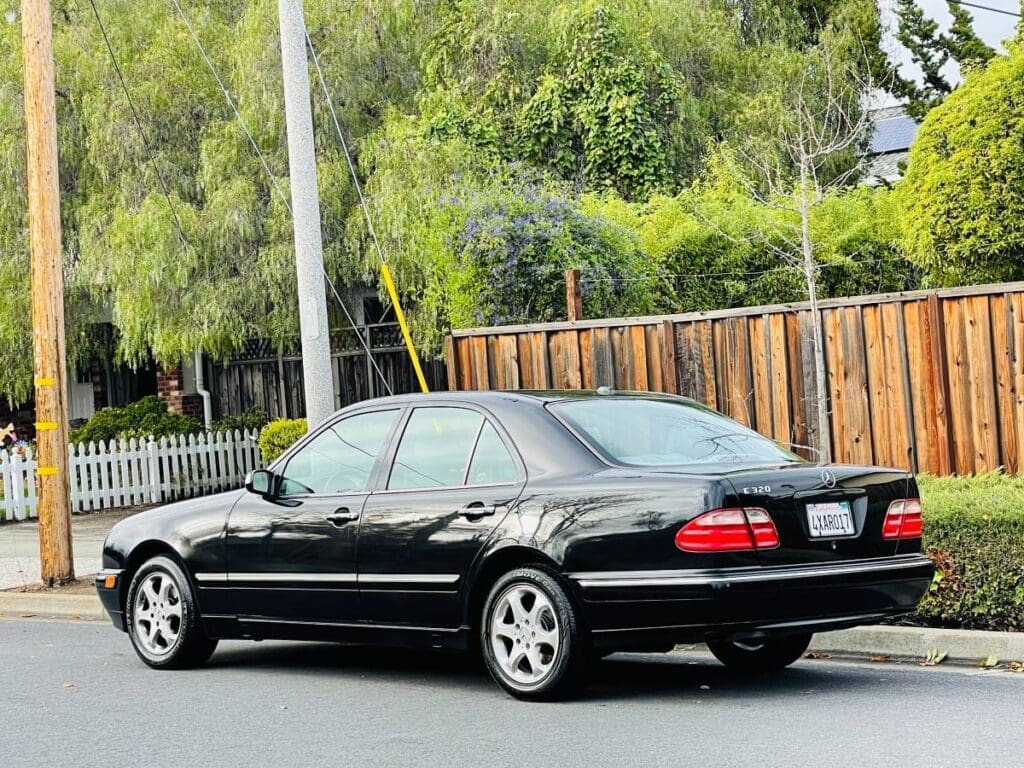
Under $10,000
- Watch out for wiring issues in W124s, rust in early W210s, and balance shaft problems in 2006-2008 W211s
- Aim for models from 2000 or later for better engine options and fewer rust issues
Despite its significant sticker price when new, a used E-Class can be surprisingly affordable. In a recent search on Autotrader, we found over 100 accident-free examples with less than 150k miles for under ten grand. Most in this range hail from the earlier generations, particularly the W210 and W211 series, along with a handful of W124s, the E-Class elder statesman. These cars are now at least a dozen years old, so it’s essential to be picky and look for the best-kept examples. In addition, keep these tips in mind:
When looking at W124-generation cars (1986-95), note that some from the later years suffered from biodegradable wiring harnesses. Most will have been replaced by now, but if you note any electrical gremlins, such as intermittent power loss, this can be a sign that the pricey repair still needs to be carried out.
Early versions of the W210 E-Class (1996-2002) can be rust-prone, especially before its 2000 model year refresh. For that reason, we suggest sticking to 2000 or newer versions, which also benefit from easier-to-maintain V6 and V8 engines plus a more responsive five-speed automatic transmission.
When the W211 generation (2003-09) switched to larger-displacement engines for the 2006 model year, some early versions had a problem with balance shafts that could result in timing chain failures and, potentially, severe engine damage. Many affected cars were fixed under warranty, and Mercedes had remedied the issue by the W211’s final model year (2009). Nevertheless, if you’re considering an E350 or E550 from 2006-08, double-check its service records to ensure the issue has been addressed.
Our pick under $10,000 would be the 58k-mile 2002 E320 sedan pictured above, which we found on Craigslist in the Bay Area for $8,000. Aside from the low miles, it also benefits from being a final-year example of the W210 series, meaning that Mercedes had fixed all the early teething issues from that generation. In addition, the seller boasts, “We’ve spared no expense maintaining it.” That’s always a good sign.
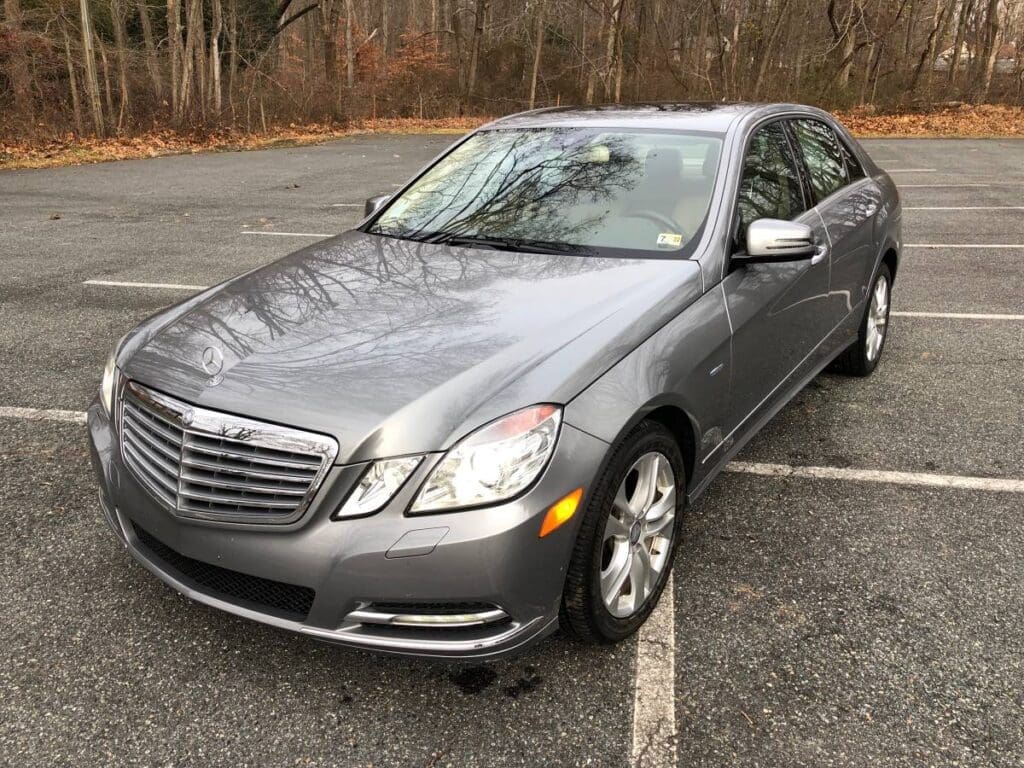
$10,000 to $20,000
- Consider W212 models for a modern interior and improved safety, but be cautious of those with Airmatic suspension
- W210 E55 AMG models offer high performance at a relatively affordable price but are increasingly rare
Adding $5,000 to $10,000 to the bottom line brings plenty of W212-generation E-Class examples into the mix. The W212 offers a far more modern interior, better fuel economy, more safety, and more power than earlier E-Classes. And by most accounts, they are fairly reliable cars, with the possible exception of those fitted with the Airmatic suspension (typically the V8-equipped E550).
If it’s sheer performance you’re after, you can also find some nice W210-generation E55 AMG specimens for sale in this range. They’re the most affordable of all of the E-Class performance variants right now — though possibly not for long. Collectors have started to take notice. They’re also quite rare, especially in good shape, so tracking one down may take some patience and some digging.
Our pick in this range would be the one-owner 2011 E350 Bluetec sedan pictured above, which we found on Craigslist in the Baltimore area for $16,500. With well under 100,000 miles on the odometer (86k to be exact) and fitted with one of Mercedes-Benz’s famously durable diesel engines, it’s got plenty of life left. It also boasts impressive fuel economy numbers for a roomy sedan: 22 mpg city and 33 mpg highway.
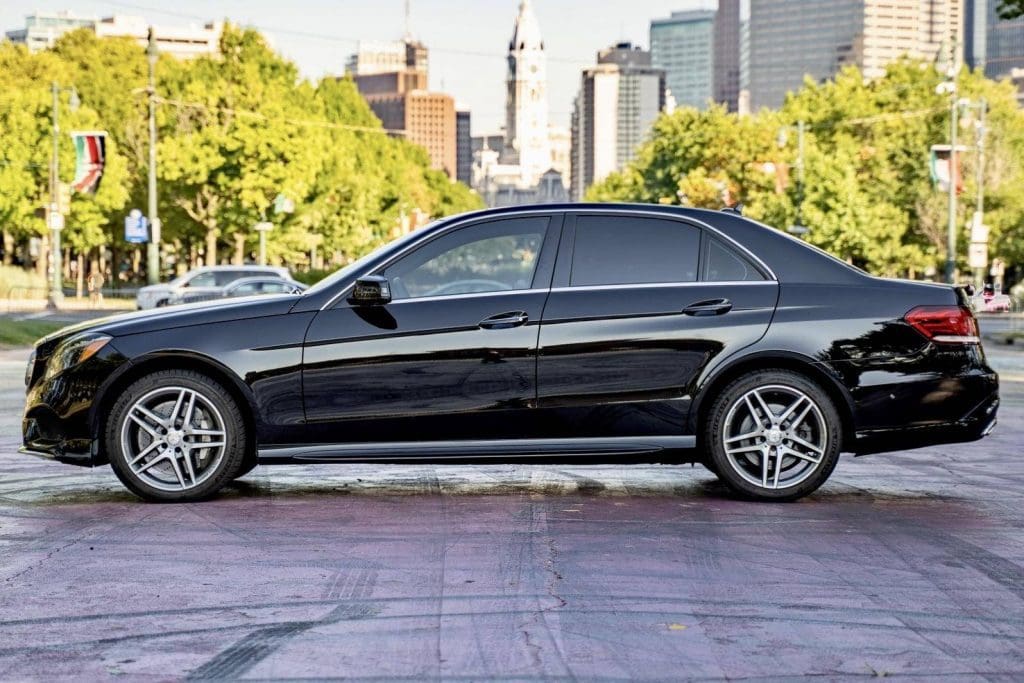
$20,000 to $30,000
- The post-facelift W212 models (2014-2016) offer the best combination of features and technology
- For a great performance value, consider an E55 or E63 AMG from the W211 or W212 generation
This range is full of exciting choices. While the newest E-Class generation, the W213, is mostly out of reach at this price point, you can have your pick of the others, whether it’s an older model with hardly any miles or a post-facelift W212 with all the bells and whistles.
You can also find plenty of excellent AMG models under $30,000. We found numerous W211-generation E55s and E63s listed in this range — even some higher-mileage E63s from the following gen, the W212. Considering their performance, that’s some serious bang for the buck.
If it were our money, though, we’d opt for the nicest 2014 E550 we could find, such as the 77k-mile example pictured above, which sold recently on Cars & Bids for $27,500. The 2014 E550 features the updated styling from the W212 model refresh of that year. It’s also the final year that Mercedes offered a V8 in the E-Class (aside from AMG models). And it’s a honey of an engine, a 4.7-liter biturbo unit cranking out 402 horsepower and 443 lb-ft of torque.
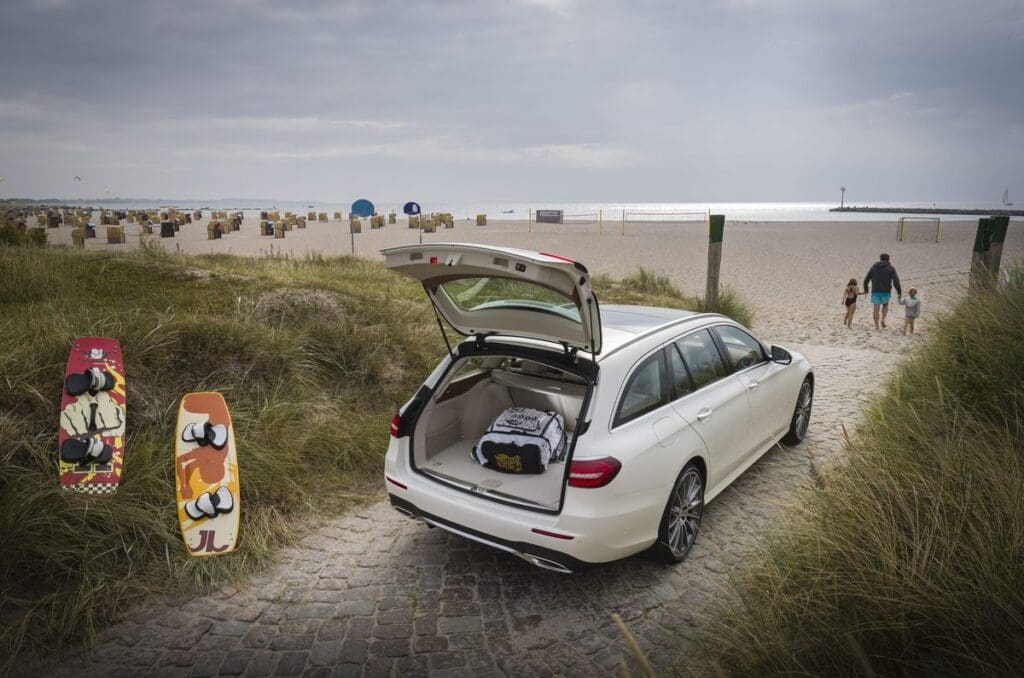
Over $30,000
- The W213 E-Class wagon offers a well-rounded package and boasts a 3.0-liter turbocharged V6
You can easily spend over $30,000 on a used E-Class, but you don’t have to. As we’ve noted above, plenty of outstanding choices are out there for less.
But if you want to splurge, we’d steer you to a W213 E-Class wagon (pictured above). For this generation, Mercedes upgraded the base engine for the wagon from a somewhat pedestrian 3.5-liter V6 to a velvety-smooth 3.0-liter turbocharged unit with 329 horsepower. While that’s not AMG levels of grunt, it’s plenty for the luxe grocery-getter, which emphasizes refinement over performance.
Late-model MB wagons are in high demand, so they don’t come cheap. Examples with fewer than 50,000 miles tend to fetch between $40,000 and $50,000. That’s a lot of dough. But considering that it buys you what Car and Driver called “truly stylish, satisfying, and special” when naming it to their 10Best list, it’s no wonder people are spending that much.
Pre-Purchase Inspections (PPIs)
Finally, before you spend thousands on a used E-Class, we highly recommend hiring a Mercedes specialist to evaluate it. For about $250, they’ll provide you with a thorough inspection of the entire car. This can reveal potentially deal-breaking issues, such as hidden accident damage or excessive engine wear, or minor things that you can use as bargaining points, like worn brake pads or aging tires.
Either way, completing a professional inspection before finalizing any used car purchase is easily worth the money.
Photos courtesy of Mercedes-Benz and Wikimedia Commons